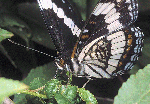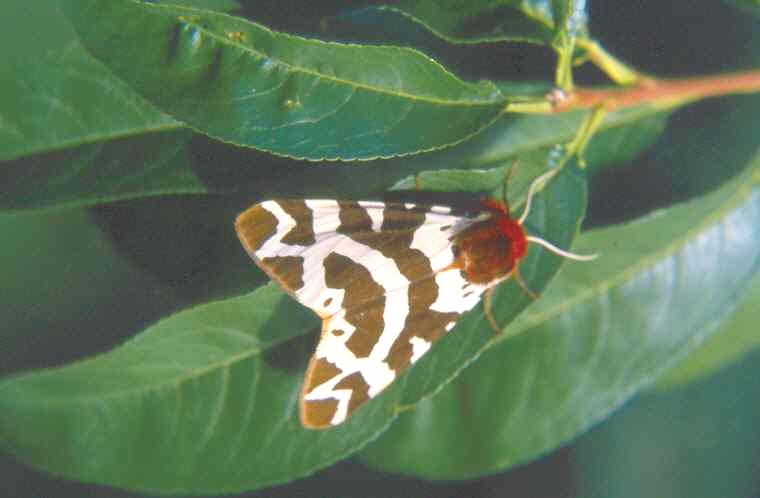
Utah Lepidopterists' Society
Founded 6 Nov 1976

|
|
Utah Lepidopterists' Society Founded 6 Nov 1976 |
|
|
|
| History | Mission | Meetings | Bulletin | Checklists | Links | Community | Field Trips | Habitat | Members | Kids | Contact Us |
Community Service
ULS Offers Support for Hogle Zoo Butterfly World
On 15 Feb 1995, ULS members Jack Harry, Ray Evenson, and Todd Stout met with Hogle Zoo Director Lamar Farnsworth and General Curator Kimberly Davidson in order to consult the zoo on the upcoming Butterfly World Exhibit to be opening later that summer.
The intent of the meeting was to discuss what species of butterflies might be available for such an exhibit, what Utah butterflies might be suitable, and what precautions the zoo should take to see to the well being of live butterflies. The issue of butterfly life histories was also brought up as Lamar and Kimberly were curious as to which species of Utah butterflies could be successfully raised in the exhibit so that passers by could possibly witness their life history. The intent was to have zoo employees seek out butterfly immatures in nearby canyons.
The consensus of the three ULS consultants is that the Hogle Zoo should contact Butterfly World in Coconut Creek, Florida (Fort Lauderdale) to see what species of butterflies adapt best to a "closed" environment and what their concerns were. At the same time, Jack recommended that Lamar purchase "Butterflies of North America" by Jim Scott as a good initial reference for butterfly identification and taxonomy. Ray recommended which commercial butterfly livestock sources might accommodate the zoo, and Todd committed to writing a summary of recommendations from all three consultants.
Todd later wrote Lamar and Kimberly on 1 Mar 1995 and, in a nutshell, recommended that the Zoo pick up copies of Butterflies of the Rocky Mountain States by Ferris and Brown as well as Weeds of the West by Whitson for identification and taxonomy. He also introduced them to Bioquip as a good general source for lepidoptera supplies. Todd also discussed basic rearing techniques and recommended local stores for containers, terrariums, and so forth.
On 10 Jun 1995, after several months of
dedicated planning by Director Lamar Farnsworth and General Curator Kimberly
Davidson, Hogle Zoo introduced Butterfly World to the public. Since its
opening, thousands of impressed Zoo spectators have passed through with nothing
but praise and wonder for Butterfly World.
The Zoo's marketing officials did a
fine job of introducing Butterfly World by announcing its opening through local T.V. and
Newspapers as well as putting up billboards (see lower right) all over town.
|
|

|

|
|
Setting aside the option of rearing and capturing local butterflies, Farnsworth opted to purchase butterfly pupae of North American species from any of three Florida vendors. The species flying at Butterfly World this summer are as follows: Battus philenor, Battus polydamas, Papilio cresphontes, Papilio palamedes, Papilio troilus, Papilio polyxenes, Phoebis philea, Eurema nicippe, Phoebis sennae, Agraulis vanillae, Anartia jetrophae, Limenitis archippus floridensis, Dryas julia, Heliconius charitonius, Danaus gilippus, Danaus plexippus, Marpesia petreus, Polygonia comma, Polygonia interrogationis, Siproeta stelenes, and Vanessa cardui.
 Passers through Butterfly World seem most interested with the Emerging Box
where received pupae from Florida are prepared by Gina and Chris to hang until
they enclose. Oddly enough spectators keep asking, "Are those alive?"; even
though the sign above the Emerging Box says, "Live Chrysalis."
Passers through Butterfly World seem most interested with the Emerging Box
where received pupae from Florida are prepared by Gina and Chris to hang until
they enclose. Oddly enough spectators keep asking, "Are those alive?"; even
though the sign above the Emerging Box says, "Live Chrysalis."
One of the more intriguing aspects of Butterfly World is how differently certain species have adapted to this indoor facility. Although fond of nectar sources like Buddleia and Lantana, Upper Sonoran species such as Danaus plexippus and Vanessa cardui seemed to spend their free time on the window wells trying to escape rather than adapting to their environment. This is not too much of a surprise considering that both of these species are highly wary and migratory. What was puzzling was that localized Lower Sonoran species such as Limenitis archippus floridensis and Siproeta stelenes also seemed to scheme with the Monarchs and Painted Ladies in attempting to escape. (Ironically, one wild, local Papilio rutulus was spotted trying to enter Butterfly World from the outside.)
 On the other hand, Sub-tropical species like Battus polydamas, Battus
philenor, Phoebis philea, Papilio cresphontes, and Anartia jetrophae
adapted very well to the exhibit. These species were often seen mating as
well as spending a lot of time flying around and nectaring on flowers.
On the other hand, Sub-tropical species like Battus polydamas, Battus
philenor, Phoebis philea, Papilio cresphontes, and Anartia jetrophae
adapted very well to the exhibit. These species were often seen mating as
well as spending a lot of time flying around and nectaring on flowers.
In fact, the Zebra Longwing, Heliconius charitonius, seemed to be the most well-adapted and visibly aesthetic of all the rest of the butterflies. Dozens of Zebras could be seen at any given moment gayly flying around the tops and through the Ficus trees as if they owned the place. What a sight to behold! Gina Phillips agreed; jokingly stating that next year Butterfly World ought to exclusively order charitonius and call the exhibit, "Zebra World." If it weren't for the potential confusion between the Zebra Longwing and the black and white striped horse from Africa, the Hogle Zoo just might have considered it.
Todd L. Stout--Editor Utah Lepidopterist
ULS Supports the Utah Museum of Natural History with the "Collectors Cabinet" Exhibit
In
July of 2001, Christy Bills, Entomological Collection Manager of the Utah Museum
of Natural History contacted U.L.S. president Col.
Clyde Gillette and requested help from the Utah Lepidopterists=
Society with a project that the UMNH would be undertaking for early 2002.
The
project that the museum would be undertaking would be to honor Utah=s butterfly and moth collectors with an exhibit called
AThe Collector=s
Cabinet.@
After
Clyde delegated the project to Todd
Stout, and, after some initial consultations between Todd, Christy, and UMNH
director Karen Willis, the ULS formed a project committee consisting of Col.
Clyde Gillette, Jack
Harry, Steve
Sommerfeld, Jacque
Wolfe and Todd Stout to work on the project.
After
a meeting in October of 2002, the project was broken down into three
subprojects. The first of which was
to assemble dozens of species of pinned Utah butterflies and moths and create
the major display. This was
assigned and heavily worked on by Jacque Wolfe and Steve Sommerfeld with some
help from Jack Harry. (See below
left.)
 |
 |
 |
| Main Exhibit as put together by Jacque Wolfe and Steve Sommerfeld. |
Portion of the Utah Lepidopterists= Society poster designed by UMNH Manager Karen Willis. |
ULS Project members Jack Harry, Jacque Wolfe, Todd Stout, and Col. Clyde Gillette (Steve Sommerfeld not pictured.) |
The
second subproject was to design an eye-level graphic of the life cycle of four
species of butterflies. This was delegated to Jack Harry and Todd Stout mostly
because of Jack=s
expertise at close-up photography. The
four species chosen for the graphic were Papilio xuthus, Adelpha
bredowi, Colias canadensis, and Neophasia
menapia.
All
of these species immatures were shot by Jack Harry excepting Neophasia
menapia which was shot by Todd. The
overall design of the life cycle plaque was designed by Karen Willis and Todd
Stout. In fact, even though most of
the raw material was donated by the Utah Lepidopterists= Society, Karen Willis provided the lion=s share of the design, creation, and implementation.
She did a wonderful job.
The third subproject was to design a collage of pictures of members of the Utah Lepidopterists= Society along with a summary of its Mission Statement. This subproject was assigned to Clyde Gillette who did a good job at providing the necessary materials. He also designed a marketing piece along side the exhibit introducing the society to museum guests..
The
final meeting between the ULS committee members and Karen Willis was on 15 Feb
2002 where all three subprojects came together and the exhibit was soon to go
public. Soon thereafter, the entire
project was finished and the exhibit was unveiled.
ULS Committee members once again met with Karen Willis who seemed very
pleased with the efforts provided by the Society to put this together.
It was a job well done by all involved.
The exhibit stayed at the Utah Museum of Natural History until November 2003 when it was finally dismantled and replaced by the museum=s next project.
Valley Fair Mall Insect Exhibit 1991-1994
On Saturday, February 19, 1994, members of the Utah Lepidopterists' Society supported the fourth annual Valley Fair Mall Insect Exhibit. The Exhibit, originally spearheaded and largely supported by Ray Evenson and family, gave the public a chance to see portions of different collectors' private collections. Other participants in the show this year were John Richards, Jack Harry, Jacque Wolfe, Ken Tidwell, and Todd Stout. This year, the exhibit was not held during the month of September, as it was during the previous three years, in order to accommodate the participants' and the mall's schedules.
Many visitors in the mall seemed amazed and fascinated at the exotic insects shown--especially Ray Evenson's Walking Sticks, Scorpions, Moths, and Beetles from around the world. An additional benefit to the exhibit was demonstrations by Ray Evenson and Jack Harry on how to mount butterflies and moths. And, as if that were not enough, many became mesmerized by John Richards' 4 1/2 year old female tarantula, "Rex." Oddly enough, it seemed that children who were passing by had an easier time appreciating "Rex" than did the adults.
During previous years, the Valley Fair Mall Exhibit has received additional support from the local media by providing information which resulted in articles and photographs in the Salt Lake Tribune and the Deseret News. However, this year, because of the proximity in time to last September's show, members of the Executive Committee opted not to provide the media with a News Release. In spite of this fact, Ray, John, Jack, and others felt pleased about how the Exhibit turned out.
During his President's message, written in the last issue of Utah Lepidopterist, John Richards expressed an increase in membership as well as an increase in the Society's visibility in the public eye as a couple of his important objectives. Based on the number of individuals who have passed by and have seen what the Society has to offer, it appears that this objective's fulfillment is on its way.
Valley Fair Mall Exhibit Photo Gallery
 |
 |
 |
 |
"Insects of the World" get a ULS Renovation
In late October, 1992, officials from the Hogle Zoo contacted ULS member Ray Evenson and requested help associated with water damage as well as some apparent sun bleaching of their Insect Collection that was donated earlier to the Zoo by former ULS member Cliff Miles.
For several weeks, Ray worked with the Hogle Zoo in getting the renovation project off the ground. Ray later contacted other ULS members to assist in the completion of the renovation project. The project was finally finished in January of 1993 when ULS members Jacque Wolfe, Jack Harry, John Richards, and Todd Stout assisted Ray in the removal and replacement not only of the damaged canvass but of certain specimens that had been damaged and sun bleached.
Ray provided insect species replacements (and in some cases repair) of several exotic species while Todd, Jacque, Jack, and John provided replacements of some local butterfly species such as the mourning cloak (Nymphalis antiopa,) Viceroy (Limenitis archippus,) Weidemeyer's Admiral (Limenitis weidemeyeri,) Western Tiger Swallowtail, (Papilio rutulus) and the Two-Tailed Swallowtail, (Papilio multicaudatus.)
 |
 |
All images of Limenitis weidemeyeri on the ULS Info Bar courtesy Jay Cossey